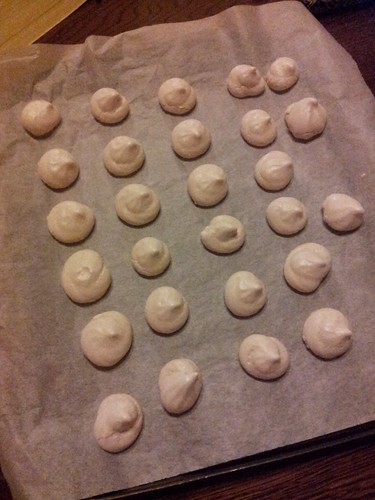I’m surprised but it seems as though I’ve never posted a basic meringue recipe. This is very remiss of me, because, if you’re anything like me you’ll often find yourself with a rogue egg white that needs using up. Perhaps after you’ve made pastry for a quiche lorraine, for example!
Before a ‘recipe’ (such as it is) some notes on egg whites and meringue making in general.
Fresh is best. Don’t use an ancient egg, and don’t use an egg white that has been hanging around in the fridge for a week. However, egg whites freeze really well. If you don’t think you’ll be able to use it up quickly, simply put it in a clean container and freeze. Egg whites defrost quickly and they’re as good as new.
If you can use an egg white that’s at room temperature, that’s better still.
Fat is your (meringue’s) enemy. Freezing the egg white? Use a scrupulously clean container. Cracking it into a bowl or ramekin? Scrupulously clean. The bowl you’ll be beating it in? Scrupulously clean.
I cannot emphasise that enough. NO FAT.
The recipe below scales up easily and, with just two ingredients, there’s no excuse for not giving it a try.
The real question is … should a meringue be gooey in the centre or crisp the whole way through?!
Ingredients
- 1 egg white
- 55g caster sugar
Instructions
- Preheat your oven to 100°C (conventional). If you're in a bit of a hurry about 140°C is as hot as you want to go. If you are cranking up the temperature, you'll need to keep a close eye on the meringues to make sure they're not taking on too much colour.
- Alternatively, cook something like a cake and turn off the oven. Leave the meringues in as the oven cools - even overnight.
- Beat the egg white until quite stiff. The stiffer it is, the glossier and firmer your meringue mix will be and the easier it will be to manipulate.
- When the egg whites are stiff, add the caster sugar slowly while you continue to beat. If this is your first time making meringue, add the sugar a tablespoon at a time. Otherwise, use your cooking wisdom to guide you.
- Ensure the sugar is really well beaten into the egg white. The mix should be smooth and glossy and not at all grainy.
- If you wish to make mini meringues (the best type for cheeky tea time treats!), scope the mixture into a piping bag fitted with a wide, fluted nozzle. Pipe the meringues on to a baking tray lined with baking paper.
- Of course, you can make any shape or size you want: using a teaspoon or a tablespoon works just as well, even if the finished product isn't quite as dainty.
- Cook in the low oven until dried out and crisp.


Hi Alex Congratulations you won the cocktail shaker maker on Desire Empire. Please contact me with your address details.
Thanks
Carolyn
Done! Thank you so much!